Advertising Case Study
Leveraging a Two-day Conference for a Year’s Worth of Content
Most people are aware that event production goes hand-in-hand with integrated marketing and advertising. It’s assumed that event production teams can plan and execute an event. But why would someone turn to an agency that deploys cutting-edge, integrated marketing technologies for advertising and branded customer experiences to plan and drive the success of this type of event? Content.
Authentic content, relevant content, engaging content. And more advertising content. See the big picture? Do you know what this means? We have planning an event down to a science—so do most top event planning companies, but (and that’s a big BUT) do they plan to maximize your opportunities to leverage all of the content that could be generated out of a two-day event? In all possible marketing channels, for far longer than the two-day event? We do, and we do it well.
A top integrated agency has all the elements and talents in one place to supercharge your event strategy—a true capability to take your brand and event to the next level. To create a successful event, we now aggregate everything that comes out of the event and leverage it for the rest of the year for the success and growth of the next event.
One event equates to a year’s worth of marketing-centric assets to increase the brand footprint, reduce costs, and translate the event results for the following year. Talk about great return on investment!
“The marketing is definitely flying on many cylinders. As we keep pursuing many channels to get our message to prospects it will continue to bear even great fruit!”
—Client’s Sales Manager
So, not only does an integrated marketing and advertising agency, such as FabCom, plan a more successful event (hyper-segmented cohort-specific communications) than an event planning company, top agencies optimize the event while it’s happening for maximum interaction (4K live-stream, merchandising, on-site social media team, on-site show flow coordination, just to name a few), and harness all of the content that’s created during the event (plan and record the entire event to yield the most powerful customer experiences and potential content, and capture one-to-one brand interviews). The agency then becomes responsible for building the content (capture the content with the intent to extract for advertisements, event promotions, and customer interactions) for the rest of the year to create a more successful event the following year.
Planning the first-year conference
One of the marketing firm’s clients wanted to bring together colleagues and clients to create a typical workshop sales event to discover and train the various uses of their open source software platform within their targeted industries. After talking through scope and logistics, the client needed a cohesive event strategy. FabCom worked with the client to develop the opportunity to make this event a first ever approach within the industry, thus the conference strategy was born.
While an integrated agency facilitates all aspects of event planning, including but not limited to venue and hotel booking, administering programs and show-flow, live event coordination of speakers’ presentations and event content, there are many value-added aspects put into play that a typical event planning company or in-house doesn’t consider.
Ninja thinking
The event strategy was based on creating an arms-length brand around the event nomenclature and conference identity and leveraging it as a third-party digital validation of the main brand to drive digital equity and superior quality content.
This was accomplished through meticulously-designed elements to promote brand cadence and capturing the entire event in 4K video for live-streaming and future distribution of marketing and aggregation of new advertising promotion through the live video capture. Hyper-segmented and content-specific targeting and dynamic advertising messaging to multiple segmentations was created in stride by bringing together thought leaders and event attendees from all over the world.
As it was the inaugural year, a significant amount of event marketing strategy was put into play to create momentum for the coming years. The main goal of year one was bringing together available thought leaders from the client’s contacts and relationships to present talks, case studies, and panel discussions promoting the use of industry software. As a result, the teams would glean the content recorded and create the needed momentum validations and excitement for the successful promotion of the next year’s conference and the parent brand.
Situational SWOT
There are many steps to planning and executing an event to the level of sophistication seen at this inaugural event. This advertising case study breaks down the situational SWOT and details the agency’s value-added strategy concepts and turnkey event implementation to make this brand-building initiative successful.
Strengths
Client had a rolodex of existing relationships with thought leaders in related industries to leverage for the first year’s targeting.
Client already planned a more focused workshop sales and employee event— thus, reducing risk by 50%.
Weaknesses
No one attends the first year of a conference with the exception of contacts asked to present.
Targeted event attendees must see tangible value without proof/review of previous events.
60 days lead time from go-forward direction to the event production date.
Opportunity
No other similar format for an industry-wide event has been produced for this industry sector.
Leveraging a budget-neutral, non-scalable sales workshop the client was planning into an immensely scalable and brand equity-producing event.
Cross-pollinate industry experts and happy users around existing customers to drive loyalty and customer goodwill.
Threats
Position of industry “best experts” or true “thought leaders” was open to take or lose to another brand in the reemerging category.
Scaling up the costs to the level required to get stakeholders outside the brand’s existing relationships to come to the first-ever event.
Event advertising, positioning, and messaging
Marketing research and analysis is the critical starting point for strategic thinking. Integrated marketing and advertising pros separate the market research trends, events, and key issues into their component parts to determine the significance of each and then reassemble them to maximize clients’ advantages. The result is effective, high-impact marketing and advertising that costs less to implement because it has the focus and structure to penetrate the target markets and motivate specific actions.
To create an intimate atmosphere, the agency dynamically segmented companies within the open source community matching the client’s areas of industry concentrations into content segments and positioned the conference as an event dedicated to the top thought leaders in the industry. Thus, creating a future advantage for the content and platform.
Twenty-five different speakers from thirteen companies were invited to present and share their insights to foster thought leadership conversation within a professionally leveraged format. This year’s purpose was not to generate revenue—as the client was striving to convert existing relationships through marketing and existing sales funnel leads by expanding the community, engagement, company relevance, and education.
![]()
Year two will see the marketing agency maximize year one to expand the event to wider audiences unknown to the client, that the client wouldn’t have connected without the conference brand, value equation, and organic authenticity created first.
Based on in-depth research, the agency engineered an event identity, independent of the existing brand, by leveraging their same key words, positioning the investment to align with advertising, and produce waterfall digital content. The key was authentically capturing thought leadership, projected to function as a coherent, connective, and convertible, year-long campaign for the brand. The cross-disciplined agency team focused on capturing the educational element of the event and the benefits the attendees would enjoy.
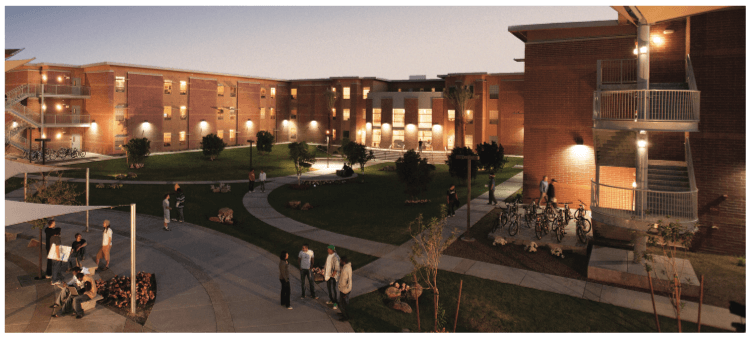
How to pick a conference venue
The event production team needed to create an atmosphere of intimate, tech-related learning. Since the initial reason for the conference was to bring together thought leaders within enterprise resource planning (ERP), the agency knew another client (a technology university) would be the ideal host. Not only did this benefit both clients by keeping costs low and promoting the campus, but the theater and classrooms created the perfect atmosphere.
The integrated agency production teams designed and planned the details of every piece of branded material, distribution, and how it fit into the environment. By creating signage, designed with thought leadership in mind, at high navigation points, attendees were able to easily find their way around the campus.
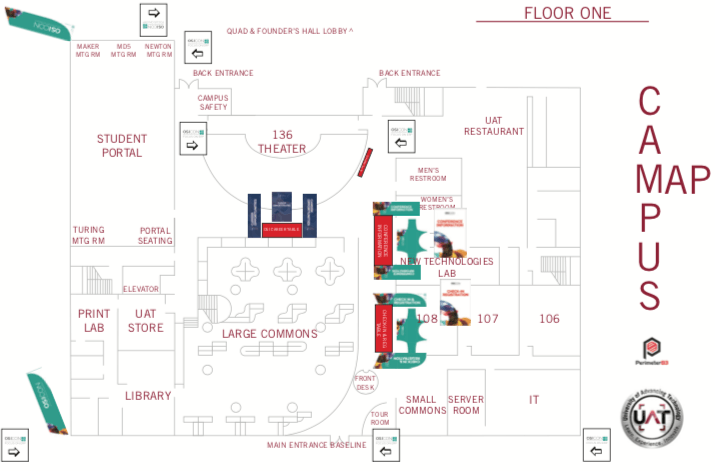
Same type of people, different demographics
Not only was the location, size, and atmosphere ideal for this education forum, but as a technology university, the attendees, speakers, and students all share similar interests. This created great energy and promoted the educational feel of the conference through the camaraderie with similar-minded individuals.
How to create event pricing through price anchoring
The agency created incremental value for the first ever event through positioning of premium-tiered experiences to merchandise ticket values through price anchoring. Price anchoring is a pricing strategy that refers to the tendency to rely heavily on the first piece of information given when making decisions. Meaning, display the product you want to sell at the price you want to sell it at next to similar products at different price points. Because of this cognitive process, a $10 ticket is more likely to sell if it’s seen next to a $100 ticket. Research has shown that if you’re offering three tiers, the ticket price you want to sell the most (e.g., the ticket price that will enable you to hit your profit goals) should be the middle price to provide the best price anchors.
There are many factors to consider when developing a pricing strategy, both short- and long-term. For example, pricing needs to:
- Reflect the value you provide versus your competitors
- Match what the market will truly pay
- Support your brand
- Enable you to reach your revenue and market share goals
- Achieve the goals and objectives for the initiative
Before developing an event-specific pricing strategy, it is critical to sync and define positioning, create the connective brand strategy, and identify the possible distribution channels. Because pricing influences how the market perceives the offering, defining positioning, brand strategy, and channels first ensures pricing reflects value and reinforces the brand. This is in contrast to undermining the connective corporate and ongoing marketing and advertising/sales messaging strategy.
It’s key to match the pricing strategy to your value proposition. An event’s price sends a strong message to the market—it needs to be consistent with the value you’re delivering. If your value proposition is operational efficiency, then the price needs to be extremely competitive. If your value proposition is product leadership or customer intimacy, a low price sends the wrong message.
To successfully price an event, understand the event’s cost structure, investment tolerance, and profitability goals. Understand how much profit the company needs to generate for sustainability (to set scalability for the next year) and success of the strategy (pay off in ROI of marketable content and positioning).
Event ticket pricing structure
In order to create the right ticket pricing structure for the event, the agency first analyzed the competitors’ prices and looked at a wide variety of direct and indirect competitors to gauge where the event price should fall. As the new conference brand and delivered value start to aggregate and align with product leadership, tickets were priced accordingly through determined price sensitivity in relationship to the initiative goals and objectives.
Introduction pricing
Originally, the agency tested a two-track pricing structure—general admission and student. After concerns that the general pricing was too high and not congruent with similar conferences, the agency added an additional track— Enterprise Software User, which became the general admission ticket. The original general admission became the Industry VIP/Presenter to create a tiered-ticket pricing structure. After reviewing the analysis of the landing page and cart, the agency also implemented an intelligence mechanism that will prompt customers with a chat box.
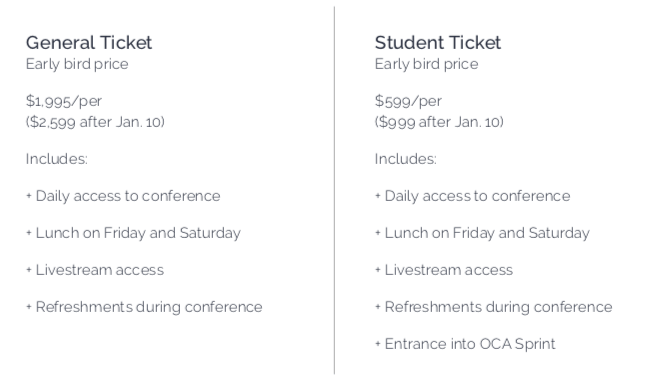
A higher price typically means lower volume. In relation to showcasing the top thought leaders in the industry, this kind of pricing strategy development also portrays a sense of exclusivity and superiority; setting the tone for what people will expect to see next year.
Final dynamic pricing structure
To create incentive and value, each ticket was priced at an early bird special and subsequently increased to full retail value two weeks prior to the event.
The result of the initial ticket prices was designed to index and reflect an esteemed event that’s top in its class. The upscale pricing strategy adds to the imbued of value, creating the feeling that if you didn’t attend, you missed out on a valuable experience.
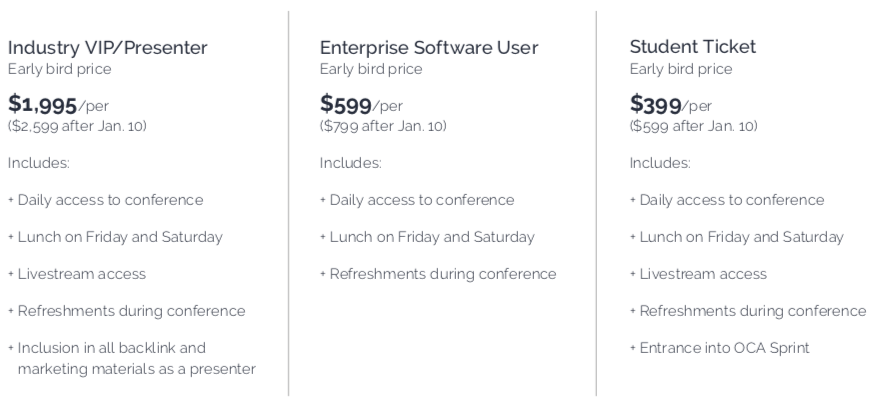
Gathering industry thought leaders
In an effort to assemble top thought leaders, two subject-specific segmented tracks were created. This was accomplished by aligning a valuable experience to current search intent threads by researching thought leaders from pertinent industries and the client’s network.
To make the conference more personalized, the client handpicked some of their customers to share personal experiences. Because the client included their contacts, the agency was able to tailor a VIP experience for them.
Focus on talks, case studies, and panel discussions
Content development requires smart, engaging words and properly micro- coded, visceral images that shine through all the other advertising noise. By focusing on engaging individual consumers in a conversation about the brand, integrated marketing firms build trust and loyalty. In a conference setting, content development comes directly from the mouths of the thought leaders.
In order to leverage the conference as an educational forum, content consisted of presentations, case studies, and panel discussions. This added focus on education provided quality content that spanned many topics, including the technical side of software—how to use software to the benefit of your business. Personal testimonials, proof of growth, and the future outlook were also featured topics.
Active social media
Because social media is among the most powerful networking platforms available today, a cross-disciplined agency integrates social media with all campaigns, including event production, and manages platforms to build conversations, reciprocity, and relationships.
Drive traffic to the event and client
The agency created a fully-functional landing page and website for the event, crafted the media promotions, and gave the client the tools to reach out to individual people. The agency designed and printed the invitations, created the EventBrite ticket page, and crafted the progressive messaging emails.
With the website framework, style, and sentiment already designed, the agency will continue to build it out for year two, making it a multiple year return on investment. The year one investment in the website also indexes the event online. Like the livestream, the website acts as an internet receipt, there will always be a thread for people to follow the conference and reflect on its perceived value. This promotes genuine interaction and helps the conference rank organically online and be found when targets are looking for an event of this nature.
For more details on creating organically-focused marketing, check out the Create Integrated Multi-Channel Organically-Focused Marketing and Advertising white paper.
![]()
Focus on building an event promotion foundation on Facebook and LinkedIn
Facebook is extraordinary for community event promotion—200 million people are members of meaningful groups, 78% of American consumers have discovered new products/businesses; user-generated content generates 6.9 times the engagement.
As a networking platform, LinkedIn benefited the client and the conference by showing transparent business connections and interactions, as well as promoting digital authority.
The strategy and tactics for social media allowed the client to start the conversation with new contacts and clients interested in open source. In addition to the agency’s video team capturing the event live, the business intelligence and social media team posted in real-time on the social platforms.
The agency made the decision to focus on Facebook because it is a community marketplace for the more seasoned audience and provides third- party validation to an event. Pre-event social media strategy included posting to promote the event, speaker updates, and enticement to register.
Student recruiting opportunity
Another benefit to both clients were the student recruiting opportunities. Since the event was hosted in the middle of a technology university, this gave the client a great opportunity for students to become aware of the brand and gave the students a chance to gain connections and network for future job opportunities.
Building new relationships and enhancing existing ones between clients and their publics are essential to leveraging brand equity, managing reputations, and establishing greater levels of trust. Public relations initiatives are not after- thoughts—they’re strategically woven into the integrated event planning.
Leads for the client
Aside from leveraging content for year two, another important goal was creating leads for the client. Through the intimate setting, the client was able to build and strengthen relationships with customers by connecting through a personal face-to-face, quality interaction.
Due to the intimate setting and handpicked attendees, the teams were able to tailor certain presentations to the client’s customers. This opened the door to touch on specific value-added benefits that gave knowledge to the conference as a whole and was uniquely specific to benefit the customer.
Through the online presence created by the live 4K video feed and active social media, the client gained qualified leads during the conference weekend, almost triple their monthly amount. The week following the conference, the client experienced 31% percent traffic increase to their website from people who normally wouldn’t have become a lead—and had a total of 108 leads generated from December to March, during the promotional period.
Year over year comparison of organic traffic follows:
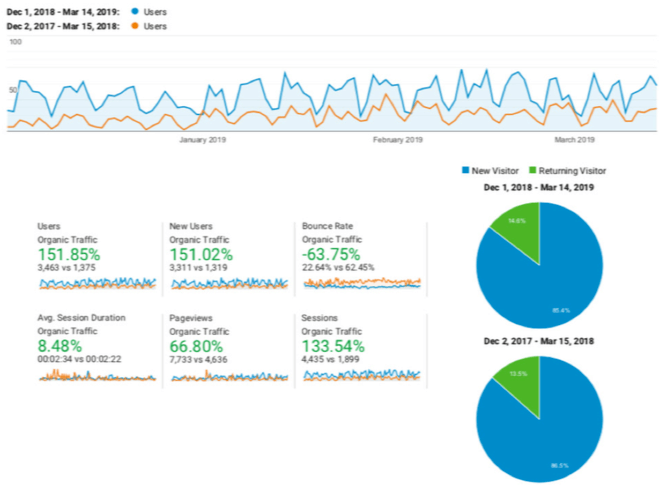
Following the conference, the agency sent out a post-conference survey to tailor next year’s experience to expectations. Using the control question “How likely is it that you would recommend [event] to a friend or colleague?” the conference received an overall Net Promoter Score (NPS) of 57. The average NPS is 26 from 179,898 organization responses.
How likely is it that you would recommend OSICON to a friend or colleague?
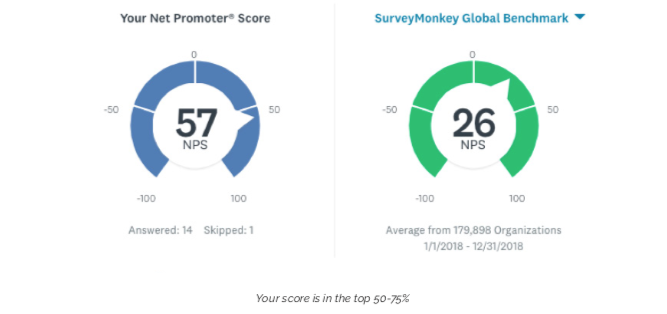
Event/environment planning with an integrated agency
The event was successful, but what made the event special? The cutting- edge or “heart” aspect came from the client and agency teams working together, each doing what they do best. Strategy and quality of design. It’s not the what, it’s the how.
The agency team performed all aspects and exceeded expectations to boost the success of the brand, the mission, the cause, and the event. The inaugural year would not have been able to reach these success heights without the cross-disciplined teams from both the client and agency.
Cross-disciplined agency pre-event planning team:
- Strategists
- Project Coordinator
- Business Analysis
- Production Manager
- Creative Director
- Art Director
- Graphic Designer
- Copywriter
- Film Production Project Coordinator
- Cinematographer
- Sound Tech
- Color Tech
- Video Editor
- Animator
Design elements
With the right corporate identity, an event can become the engine of brand growth.
With a transparent name, Open Source Integrators Conference was tactically shortened to OSICON. While the conference name is a nod to the client, the conference wasn’t created to boast about how great the client is. The event was created for the purpose of spreading open source software information to those within the industry and beyond—the client’s brand was positioned as the authentic industry thought leader working for the greatest good of the industry.
When creating the design elements, the agency team developed ideas that fueled the conference and the client’s brand with the same dollar.
![]()
Positioning of the event played a significant role in the creation of the design elements. As a tech conference, graphics needed to feel modern without looking overly techy or futuristic. Thus, the cross-disciplined design team created a modern-feeling brand through repeating circular elements.
The color pallet was chosen to closely mimic a desert motif, and offbeat colors were used to modernize the theme. Teal, white, burnt sienna, and gold, were used in contrast with each other to pull the design aspects together. This gave the entire conference a professional feel and a sense of unity from the first-impression online to the in-person learning experience.

All design assets were created by the integrated agency using the same cross-disciplined team.
- Website
- Corporate identity; logo design
- Backdrop signage
- Table top display
- Directional signage
- Pull-up banners
- Table skirts with logo
- Flags
- T-shirt designs
- Agenda programs
- Google ads
- LinkedIn ads
- Equipment map
- Facebook ads
- Flyer
- Powerpoint presentation layout
- Event tickets
- Sponsor registration
- Email signatures
- Notepads
- Nametags
- Sponsor registration brochure
Benefits of using an integrated marketing agency to produce your event
The difference that a top integrated marketing and advertising agency makes is return on your investment. When you hire an integrated agency as your event production company, you receive more than a successful event and a couple of videos squeezed from the show flow. You amass content to leverage for the next year and build up the year two conference.
| Services Provided | Integrated Marketing & Advertising Agency |
Event Production Company |
|---|---|---|
| Event/environment marketing | • | • |
| Logistics | • | • |
| Video production | • | • |
| Social media integration | • | • |
| Project management | • | • |
| Venue preparation | • | • |
| Advertising | • | • |
| Show flow | • | • |
| Staging | • | • |
| Lighting | • | • |
| Branding and positioning | • | |
| Content Development | • | |
| Corporate identity | • | |
| Marketing research | • | |
| Public relations | • | |
| Strategic marketing planning | • | |
| Website development | • | |
| Cross-channel integration | • | |
| Dynamic marketing | • | |
| Marketing business intelligence | • | |
| Media planning and buying | • | |
| Marketing communications | • | |
| Real-time dashboard reporting | • | |
| SEO/SEM | • | |
| Relationship database marketing | • | |
| Sales planning and promotion | • |
FabCom, a Scottsdale-based integrated marketing and advertising agency, has always had a mission to meticulously and seamlessly integrate all driving and contributing elements that influence end-to-end attribution, the customer experience, and marketing ROI. Every piece of marketing and advertising content produced at FabCom is visceral, effective, and strategic, including event promotion, integrated advertising, and production.
To learn more about what an integrated agency can do for your event production and promotion, visit our Advertising Services and check out our Advertising Portfolio.